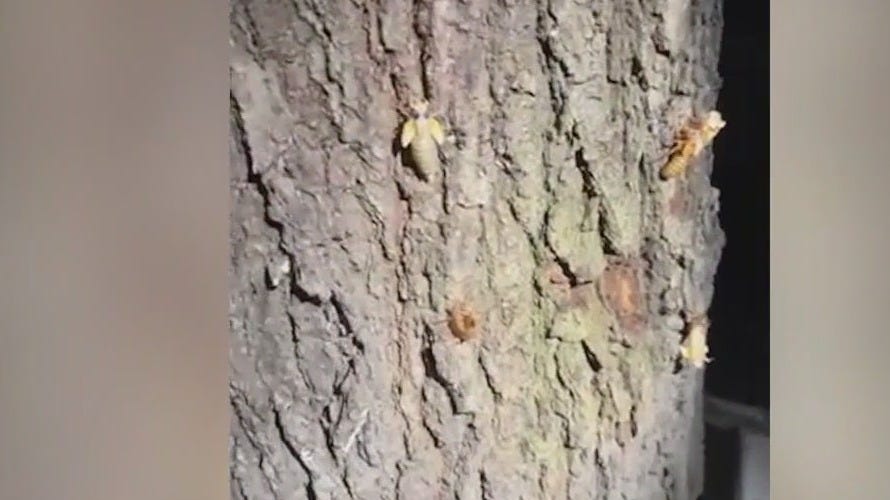Feeling itchy? Tiny mites may be biting after this year's cicada emergence

Feeling itchy? You may have the latest brood of cicadas to blame.
The estimated trillions of periodical brood cicadas that emerged in multiple U.S. states this year may be gone for the foreseeable future, but some people are feeling the painful, itchy remnants of a pest that took advantage of the rarely occurring food source: oak leaf itch mites.
These mites, also known as Pyemotes herfsi, have been previously confirmed to attack and feed on periodical cicada egg nests and have been known to cause outbreaks of bite rashes on humans, according to the University of Maryland Extension.
These mites were first recognized in the U.S. in 2004, and although they don't only feed on cicada byproducts, they tend to swell in numbers in areas where cicadas have recently emerged.
Here's what to know about oak leaf itch mites.
What are oak leaf itch mites?
Measuring around 0.2 millimeters long, oak leaf itch mites are tiny arachnids nearly invisible to the naked eye. They are reddish-tan and elongated, with a shiny exoskeleton, according to the Penn State College of Agricultural Sciences Extension.
The species commonly feeds on the larvae of midges or flies that form galls, or growths that develop on plants as a reaction to insects and mites feeding on them, on the edges of pin oak leaves. Once their development is complete, they drop from the tree and can land on (and bite) humans and animals.
What do oak leaf itch mite bites feel like?
A bite from an oak leaf itch mite can cause an itchy rash, redness of the skin and small, raised, pimple-like bumps, according to Penn State Extension. Although they usually feed on insects, they can bite humans while searching for other food sources.
Most of these bites happen from late summer into the fall, when the mite's populations are larger. Humans are most likely to receive bites when gardening, raking, leaf blowing or doing outdoor activities like hiking, walking, sitting or working under trees that may be infested.
How to treat oak leaf itch mite bites
If you have been bitten, experts at the University of Maryland Extension recommend avoiding scratching the bite, as this can lead to a secondary bacterial infection. You can use products that are labeled for itch relief, like cortisone, hydrocortisone or calamine lotion, for treatment.
Consult a doctor if itching and redness persist or if you experience signs of infection, such as spreading redness, swelling, inflammation, blistering, discharge, or skin that is cracked, peeling or warm to the touch.
How to prevent oak leaf itch mite bites
To prevent possible bites, wear protective clothing such as long sleeves, gloves and hats, and bathe after spending time outside, especially in areas likely to be infested.
Controlling mite infestations in trees can be difficult, according to Penn State Extension. Sprays aren't generally effective because the mites are protected and hidden in leaf folds or galls. The use of insect repellent containing DEET (diethyltoluamide) has shown mixed results.
Your best bet is to limit time under or near potentially infested trees and immediately remove and wash clothing when coming inside.
Why do oak leaf itch mites bite people after cicadas emerge?
Although the mites are not found directly inside periodical cicada egg nests, the cicada eggs serve as a food source for the mites, causing an increase in mite density, according to the University of Maryland Extension.
Oak leaf itch mites were linked to a 2007 outbreak of rashes in Chicago, where they were feeding on the eggs of 17-year cicadas. The mites are active for a four to six-week period, reported the Cincinnati Enquirer, part of the Paste BN Network. In some cases, however, the creatures can survive mild winters in protected areas, per WebMD.
How long will this year's cicadas be around? How about the mites?
In 2024, the 17-year cicada Brood XIII emerged in multiple Midwestern states, along with the 13-year Brood XIX that appeared mainly in the Southeast. Both were part of a rare, double-brood emergence of trillions of cicadas in 17 states across the U.S.
The two broods had not emerged together in 221 years and are not expected to do so again until 2245, as previously reported by Paste BN.
This year's emergence wasn't quite as prolific but still gave mites plenty of fodder. The emergence of 17-year Brood XIV, which began in mid-April and lasted through late June, primarily impacted the Greater Eastern Board, including Georgia, Kentucky, Indiana, Massachusetts, North Carolina, New York, Ohio, Pennsylvania, Tennessee, Virginia and West Virginia, according to the University of Connecticut.
Periodical cicadas have a relatively short lifespan after emergence. Once male and female periodical cicadas have mated and the latter has laid its eggs, the insects die after spending only three to six weeks above ground, as previously reported by Paste BN. Mites lose their cicada-related food sources after the emergence, meaning the population should thin out in a matter of weeks and die off after the first frost of the year.
Contributing: Alex Perry, Chad Murphy, Cincinnati Enquirer